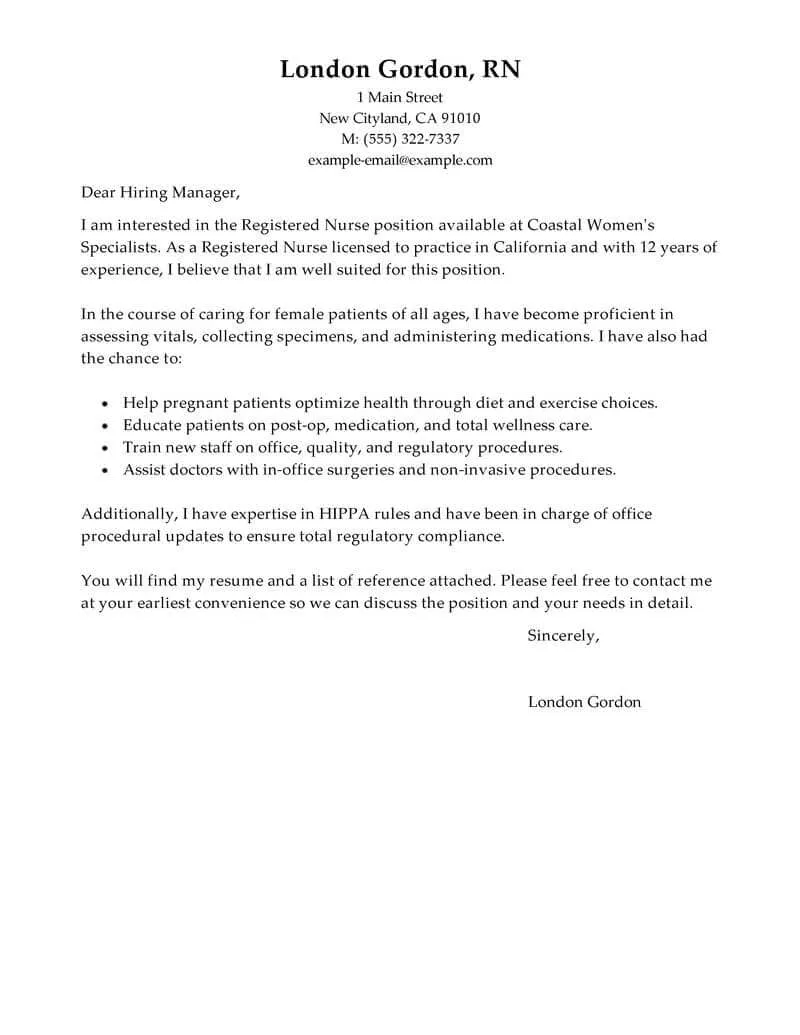Crafting a Winning Nurse Cover Letter
A well-crafted nurse cover letter is your first impression, a vital tool in securing your dream nursing role. It goes beyond simply listing your qualifications; it’s your opportunity to showcase your passion, skills, and how you align with the specific job and the healthcare facility’s mission. This guide will help you navigate the process, ensuring your cover letter stands out to potential employers. By following these steps, you can significantly increase your chances of landing an interview and moving forward in your nursing career. A compelling cover letter demonstrates professionalism and a genuine interest in the position, making it a crucial component of any successful job application.
Understanding the Importance of a Nurse Cover Letter
Your nurse cover letter serves as a narrative, providing context to your resume. It explains your career goals, highlights relevant experiences, and connects your skills to the employer’s needs. Unlike a resume, which offers a factual overview, the cover letter lets you express your personality and enthusiasm, illustrating why you’re the perfect fit. It’s a crucial chance to demonstrate your communication skills, attention to detail, and your understanding of the nursing profession. It also allows you to address any potential gaps or concerns in your resume, such as career changes or periods of inactivity, providing clarity and confidence to the hiring manager.
Highlighting Key Skills and Qualifications
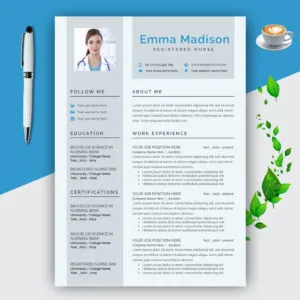
Nursing demands a unique blend of technical expertise, clinical knowledge, and soft skills. Your cover letter should highlight these aspects. Focus on the skills most relevant to the job description. For example, if the position involves critical care, emphasize your experience with ventilators, cardiac monitoring, and rapid response teams. Use action verbs to describe your accomplishments. Instead of stating “Responsible for patient care,” try “Managed care for a 10-bed unit, ensuring patient safety and satisfaction.” Quantify your achievements whenever possible, such as “Reduced patient fall rates by 15% through implementing new safety protocols.”
Researching the Hospital or Clinic
Before you start writing, research the healthcare facility. Look at their mission, values, and recent news. This knowledge will help you tailor your cover letter to the specific organization, demonstrating your genuine interest. Visit the hospital’s or clinic’s website to understand their patient care approach, specialization, and culture. If possible, network with current or former employees. Knowing the facility’s specific needs and challenges can help you align your skills and experience, making your application more compelling and showing that you have a deep understanding of their environment.
Tailoring the Cover Letter to the Job Description
Carefully review the job description, noting the key requirements and preferred qualifications. Structure your cover letter to mirror these needs. Address each essential skill or experience in your letter, providing specific examples of how you’ve demonstrated them. If the job posting mentions specific software, procedures, or patient populations, be sure to include this information. Customizing your letter showcases your attention to detail and your understanding of the position, making your application more relevant and appealing to the hiring manager. Highlighting the exact language and keywords from the job description also helps your application get through Applicant Tracking Systems (ATS).
Structuring Your Nurse Cover Letter
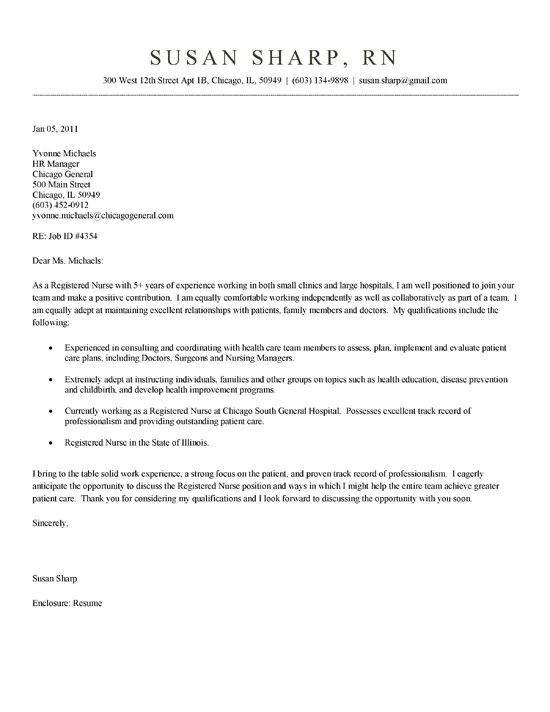
A well-structured cover letter is easy to read and conveys information effectively. The structure should include a header, an opening paragraph, body paragraphs, and a closing paragraph. Each section serves a specific purpose, contributing to the overall effectiveness of your letter. Use clear and concise language, making it easy for the reader to quickly grasp your qualifications and suitability. Maintain a professional tone throughout, reflecting your understanding of the nursing profession and your commitment to patient care. A well-structured cover letter shows that you pay attention to detail, an essential attribute for any nurse.
Header and Contact Information
The header should include your full name, address, phone number, and professional email address. Include the date and the hiring manager’s name and title (if you know it) and the hospital or clinic’s address. Ensure that your contact information is accurate and up-to-date so that the employer can easily reach you. Using a professional email address is essential; avoid nicknames or unprofessional language. Formatting the header correctly sets the tone for your cover letter and demonstrates your attention to detail and professionalism. It shows that you are serious about the opportunity and are committed to clear, effective communication.
The Opening Paragraph
The opening paragraph is your chance to grab the reader’s attention. State the position you’re applying for and how you found the opening. Briefly mention your most relevant qualification or skill. Make it clear why you are excited about this role and this specific healthcare facility. Your opening should be concise, engaging, and demonstrate your immediate interest in the position. A compelling opening piques the interest of the hiring manager, encouraging them to read the rest of your letter and learn more about your qualifications.
Writing an Engaging Hook
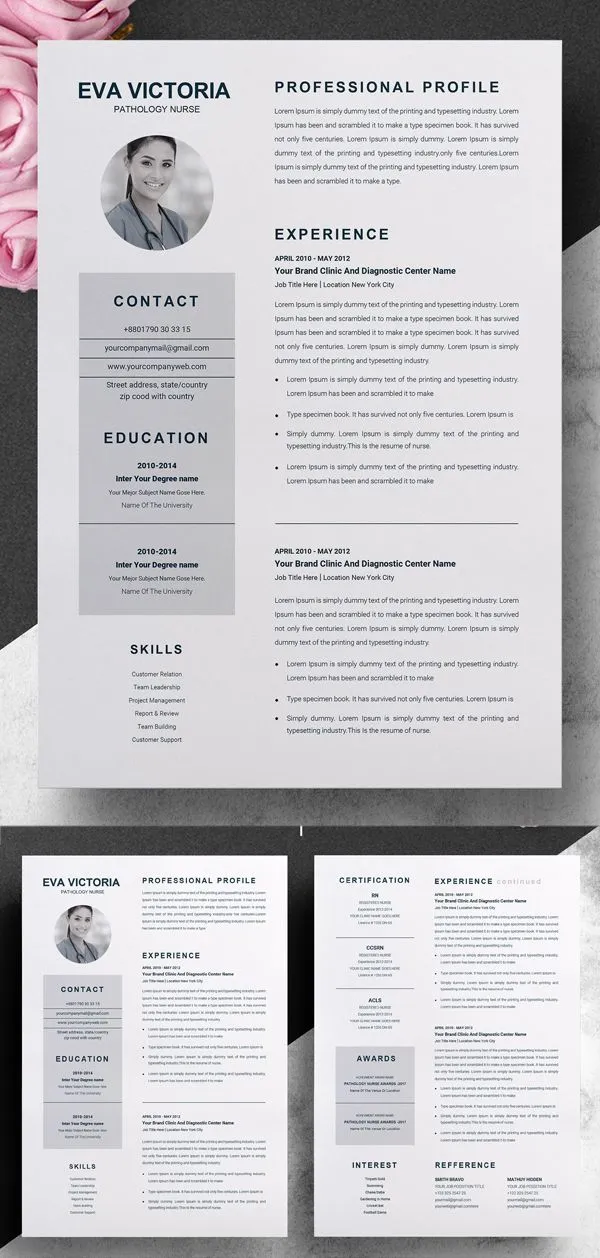
Start with a compelling hook to immediately engage the reader. Instead of a generic statement, like “I am writing to apply for the nurse position,” try a more personalized approach. For example, mention a recent accomplishment, a relevant experience, or your familiarity with the hospital. This might include a specific project you worked on or something you admire about the hospital’s mission. The hook sets the tone for the rest of your letter, making it more memorable and demonstrating your enthusiasm. Ensure that your hook aligns with the rest of your cover letter and the specific requirements of the job.
Body Paragraphs Highlighting Skills
The body paragraphs should expand on your key qualifications and experiences. This is where you provide specific examples, explain your skills, and demonstrate your achievements. Use the STAR method (Situation, Task, Action, Result) to structure your responses, providing a clear narrative of your accomplishments. Highlight how your skills align with the job description and what you can bring to the role. This section should be a detailed look at your professional accomplishments, showing the hiring manager the real-world impact of your skills and experience. Tailor your content to the specific role and highlight only the most relevant skills.
Showcasing Clinical Experience
Detail your clinical experience, emphasizing the types of patients you have cared for, the settings you have worked in, and the procedures you have performed. Highlight specialized skills, such as critical care, emergency room experience, or surgical nursing. Mention any certifications or advanced training you possess, such as ACLS or certifications specific to your field. Emphasize your ability to work well in a team, communicate effectively with patients and families, and provide high-quality, compassionate care. Focus on your experience and the impact of your role, quantifying your results whenever possible to demonstrate your effectiveness.
Emphasizing Soft Skills
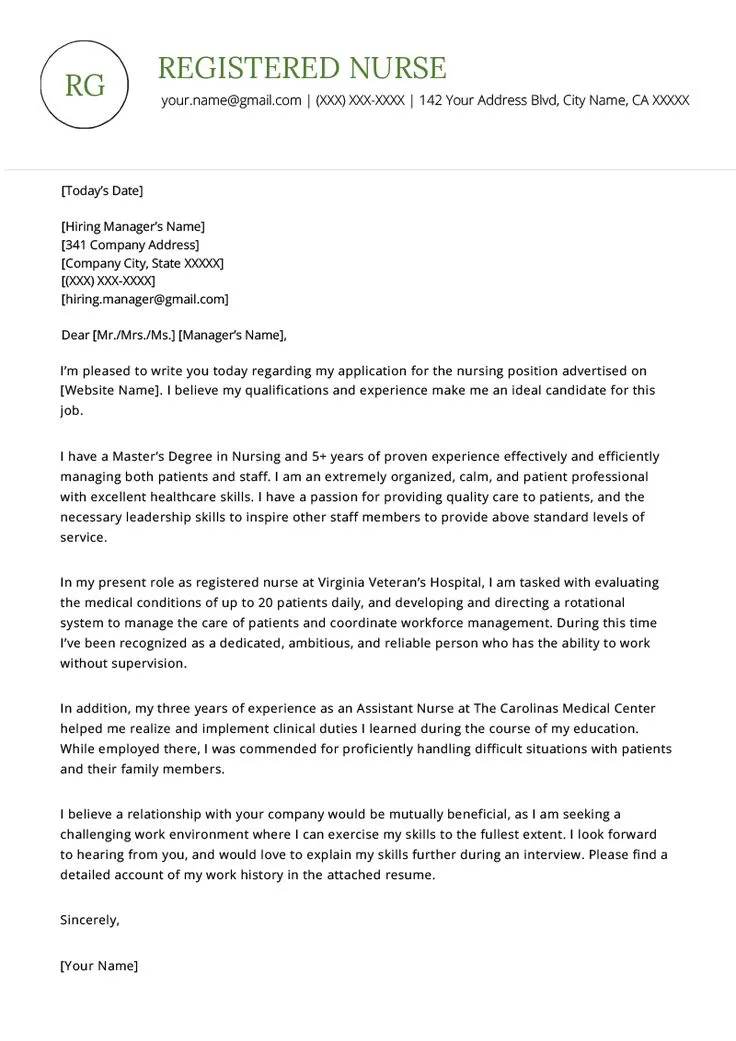
While clinical skills are essential, so are soft skills. Highlight your communication, teamwork, problem-solving, and critical thinking abilities. Give examples of how you have used these skills in previous roles. Describe situations where you resolved conflicts, collaborated with a multidisciplinary team, or handled difficult patient interactions. Nursing is a field that depends on excellent interpersonal skills, so demonstrating your ability to connect with patients and your co-workers is very important. Your cover letter should also reflect your ability to adapt to changing situations and your commitment to continuous learning and professional development.
The Closing Paragraph
The closing paragraph should summarize your interest in the position and the healthcare facility. Reiterate your enthusiasm and your key qualifications. Express your thanks to the hiring manager for their time and consideration. Always include a clear call to action, such as expressing your availability for an interview. This shows your proactive approach and demonstrates your commitment to the position. A strong closing leaves a positive lasting impression and increases the likelihood of a positive response from the employer.
Expressing Enthusiasm and Call to Action
In the closing paragraph, restate your enthusiasm and express your interest in discussing your qualifications further. Thank the hiring manager for considering your application. Include a clear call to action, such as, “I am available for an interview at your earliest convenience and look forward to hearing from you.” Provide your contact information again if desired, and always close with a professional sign-off, such as “Sincerely” or “Respectfully”. This reinforces your professionalism and desire to move forward in the hiring process.
Formatting and Proofreading for Perfection
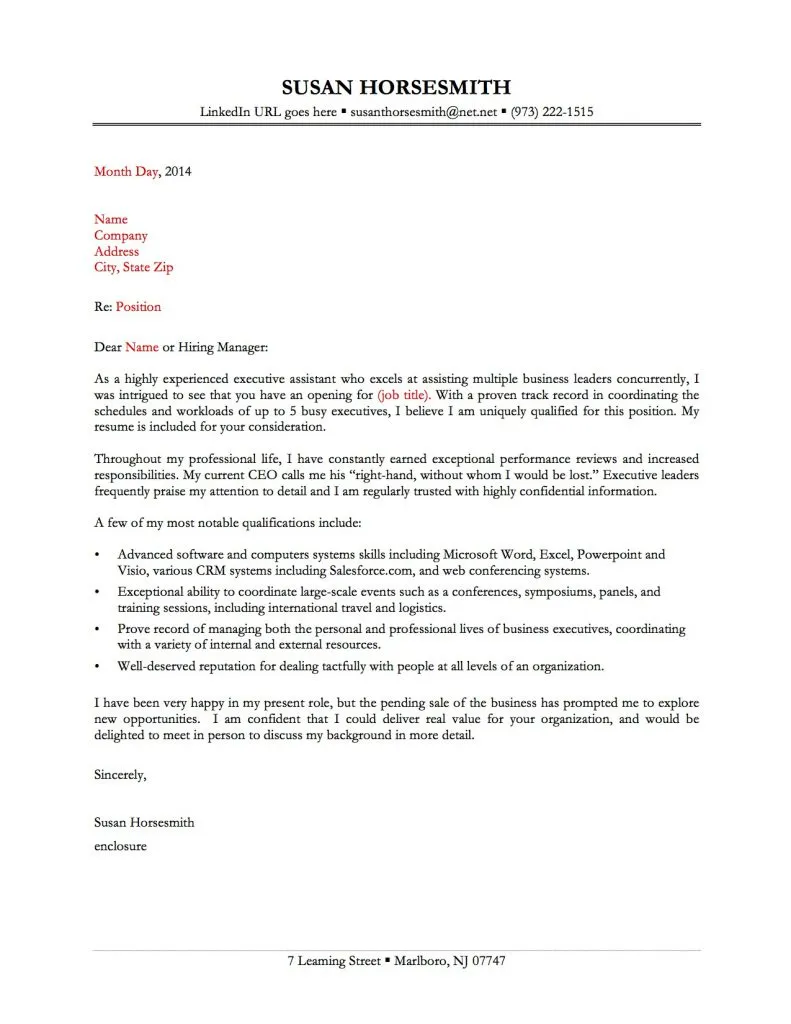
A well-formatted and error-free cover letter reflects your attention to detail and professionalism. Your letter should be easy to read and visually appealing. Proofreading is critical; even minor errors can undermine your credibility. Take the time to refine your letter and ensure it represents you in the best possible light. Ensure your cover letter is free of errors in grammar, spelling, and punctuation before submitting your application. A polished cover letter shows your commitment to excellence and attention to detail.
Choosing the Right Font and Format
Choose a professional font, such as Times New Roman, Arial, or Calibri, using a font size between 11 and 12 points. Use standard margins (1 inch on all sides) and single-space your text, with a blank line between paragraphs. Use clear and concise language, making it easy for the reader to follow your points. Formatting ensures your cover letter is easy to read and visually appealing. A clean, uncluttered layout enhances readability and makes a positive impression on the hiring manager. These small details show you care about the presentation of your work.
Proofreading for Grammar and Spelling Errors
Proofread your cover letter carefully for grammar, spelling, and punctuation errors. Use spell-check tools, but also read the letter aloud to catch any mistakes that automated tools might miss. It’s also helpful to have a trusted friend or family member review your letter. Even a small error can detract from your credibility and attention to detail, so take the time to review your letter. A well-proofread cover letter demonstrates your commitment to accuracy and professionalism.
Reviewing Sample Nurse Cover Letters
Reviewing sample nurse cover letters can provide valuable insights and inspiration. These examples can show you how to structure your letter, highlight your skills, and tailor your content. Analyzing successful examples can help you refine your writing and ensure that your cover letter meets industry standards. Comparing your work with these examples can provide useful context, helping you present your skills and experience effectively. Study these samples to understand various writing styles and how they are used effectively in different nursing settings.
Analyzing Successful Examples
When reviewing sample cover letters, focus on how the writer presents their qualifications, highlights their accomplishments, and addresses the employer’s needs. Look for examples of strong opening paragraphs, compelling body paragraphs, and effective closing statements. Notice the use of action verbs, the tailoring of the letter to the specific job, and the overall tone. Pay attention to how the writers integrate their skills, experience, and personality. Analyzing these elements helps you to create your own cover letter that is tailored to your specific needs. Also, note what phrases and keywords are being used.
Identifying Key Phrases and Language
Pay attention to the key phrases and language used in successful cover letters. Note how writers describe their skills, experiences, and achievements. Look for examples of how they incorporate keywords from the job description. Use these phrases and language styles to inform your own writing. This will help you communicate your qualifications in a clear and concise way, making it easier for the hiring manager to understand your value. By identifying and using key phrases, you can also make your cover letter more relevant and compelling.
Avoiding Common Mistakes in Nurse Cover Letters
Avoiding common mistakes will significantly improve the effectiveness of your cover letter. These mistakes can undermine your application and negatively impact your chances of securing an interview. By understanding these pitfalls and learning how to avoid them, you can create a cover letter that effectively showcases your skills and qualifications. It is important to highlight your strengths and make a great first impression by carefully reviewing your cover letter before submitting it.
Generic Cover Letters
Avoid using a generic cover letter that is not customized to the specific job or healthcare facility. Tailor your letter to each position. The employer can easily identify these types of letters, which shows a lack of genuine interest and attention to detail. Always take the time to tailor the letter to the specific job and organization, showing you have researched the position and that you are genuinely interested in the role. Personalize each letter to demonstrate your interest and increase the likelihood of landing an interview.
Focusing on Yourself Instead of the Employer
Focus your letter on how your skills and experience can benefit the employer, rather than focusing solely on your personal needs and desires. Instead of saying, “I am seeking a job,” say, “I am eager to bring my skills and passion for patient care to your team.” Show how your skills and experience align with the needs of the employer. Focus on what you can offer and how you can make a difference in the organization. Highlighting the value you bring makes your application more appealing.
Ignoring the Job Description
Make sure your cover letter directly addresses the requirements and qualifications listed in the job description. Failing to do so can make you appear unqualified or uninterested. Carefully review the job description and tailor your letter to highlight the relevant skills and experiences. The employer is looking for someone who can demonstrate that they have the right skills and experience. Mirroring the job description will make your application more relevant and improve your chances of getting an interview. Do your research and address the requirements to ensure that you stand out.
Creating a winning nurse cover letter requires attention to detail, a clear understanding of the job requirements, and the ability to showcase your unique skills and experiences. By following the tips and strategies in this guide, you can craft a compelling cover letter that helps you secure your dream nursing role. Remember to always tailor your letter to each specific job and hospital. Good luck!
